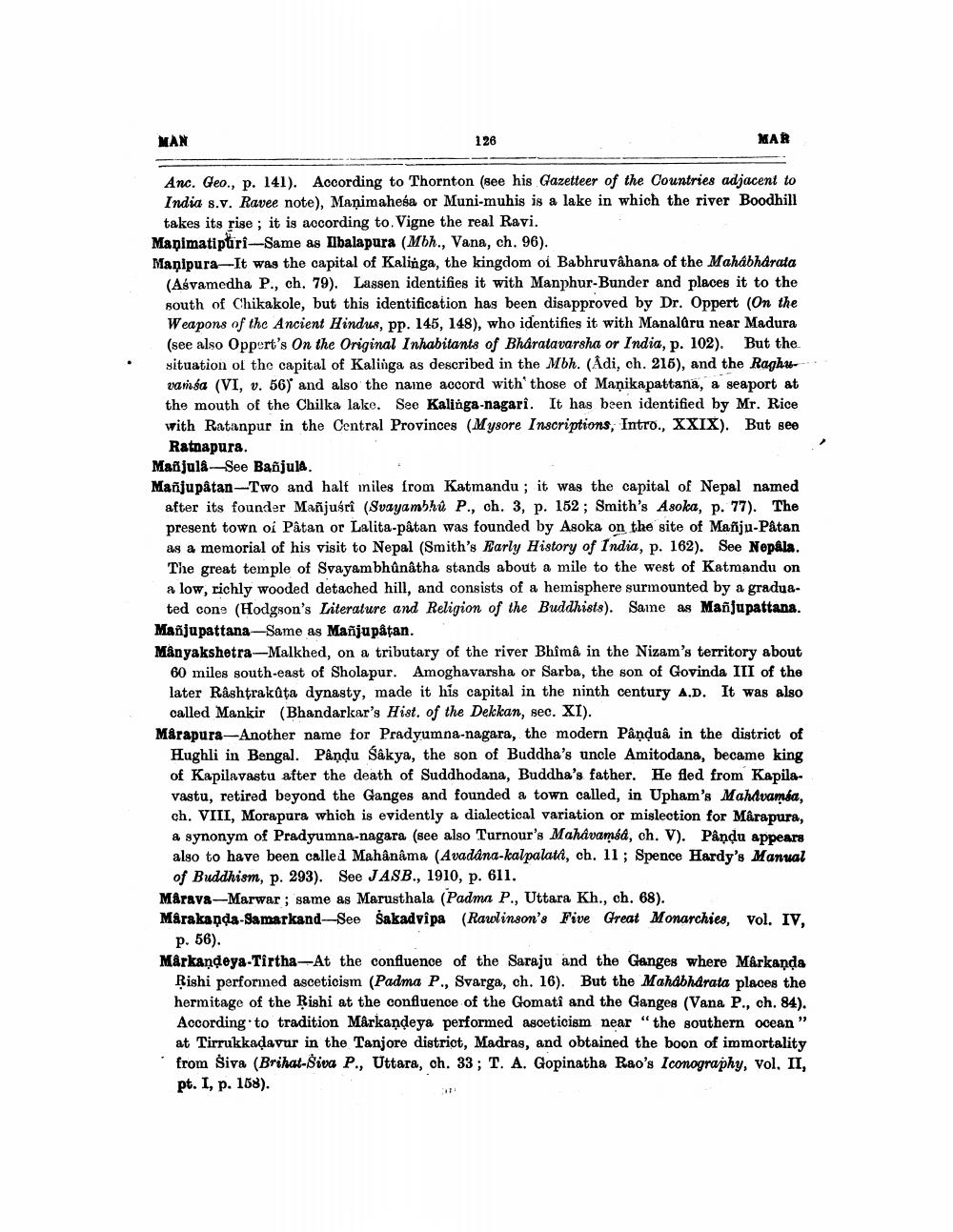________________
MAN
126
MAR
Anc. Geo., p. 141). According to Thornton (see his Gazetteer of the Countries adjacent to India s.v. Ravee note), Manimahesa or Muni-muhis is a lake in which the river Boodhill takes its rige; it is according to. Vigne the real Ravi. Manimatipuri-Same as Ilbalapura (Mbh., Vana, ch. 96). Manipura-It was the capital of Kalinga, the kingdom of Babhruvahana of the Mahabharata
(Asvamedha P., ch, 79). Lassen identifies it with Manphur-Bunder and places it to the south of Chikakole, but this identification has been disapproved by Dr. Oppert (On the Weapons of the Ancient Hindur, pp. 145, 148), who identifies it with Manalaru near Madura (see also Oppert's On the Original Inhabitants of Bharatavarsha or India, p. 102). But the situation of the capital of Kalinga as described in the Mbh. (Adi, ch. 216), and the Raghuvamsa (VI, v. 56) and also the name accord with those of Manikapattana, a seaport at the mouth of the Chilka lake. See Kalinga-nagari. It has been identified by Mr. Rice with Ratanpur in the Central Provinces (Mysore Inscriptions, Intro., XXIX). But see
Ratnapura. Manjula See Bañjula. Mañjupâtan-Two and half miles from Katmandu ; it was the capital of Nepal named
after its founder Mañjugri (Svayambhú P., ch. 3, p. 152; Smith's Asoka, p. 77). The present town oi Patan or Lalita-påtan was founded by Asoka on the site of Mañju-Patan as a memorial of his visit to Nepal (Smith's Early History of India, p. 162). See Nepala. The great temple of Svayambhûnâtha stands about a mile to the west of Katmandu on a low, richly wooded detached hill, and consists of a hemisphere surmounted by a gradua
ted cone (Hodgson's Literature and Religion of the Buddhists). Same as Manjupattana. Mañjupattana-Same as Mañjupåtan. Mänyakshetra-Malkhed, on a tributary of the river Bhima in the Nizam's territory about
60 miles south-east of Sholapur. Amoghavarsha or Sarba, the son of Govinda III of the later Rashtrakata dynasty, made it his capital in the ninth century A.D. It was also
called Mankir (Bhandarkar's Hist, of the Dekkan, sec. XI). Marapura-Another name for Pradyumna-nagara, the modern Panduâ in the district of
Hughli in Bengal. Pându Sâkya, the son of Buddha's uncle Amitodana, became king of Kapilavastu after the death of Suddhodana, Buddha's father. He fled from Kapilavastu, retired beyond the Ganges and founded a town called, in Upham's Mahdvamia, ch. VIII, Morapura which is evidently a dialectical variation or mislection for Marapura, a gynonym of Pradyumna-nagara (see also Turnour's Mahavamsa, oh. V). Pandu appears also to have been called Mahânâma (Avadana-kalpalata, ch. 11; Spence Hardy's Manual
of Buddhism, p. 293). See JASB., 1910, p. 611. Marava-Marwar; same as Marusthala (Padma P., Uttara Kh.. ch. 68). Marakanda-Samarkand-See Sakadvipa (Rawlinson's Five Great Monarchies, vol. IV,
p. 56). Märkandeya-Tirtha-At the confluence of the Saraju and the Ganges where Märkanda
Rishi performed asceticism (Padma P., Svarga, ch. 16). But the Mahabharata places the hermitage of the Rishi at the confluence of the Gomati and the Ganges (Vana P.. ch. 84). According to tradition Markandeya performed asceticism near "the southern ocean" at Tirrukkadavur in the Tanjore district, Madras, and obtained the boon of immortality from Siva (Brihat-Siva P., Uttara, ch. 33 ; T. A. Gopinatha Rao's Iconography, Vol. II, pt. I, p. 158).




